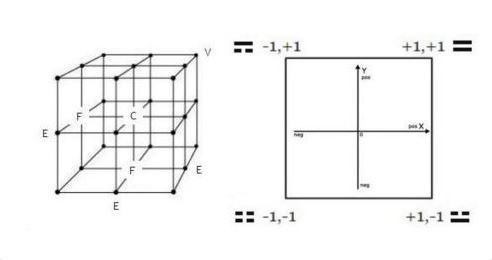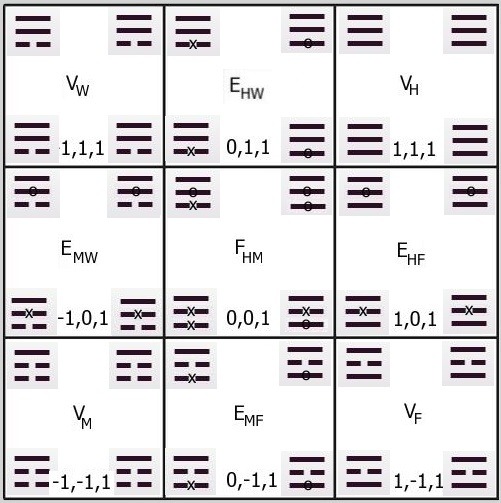#context
Beyond the Enlightenment Rationalists:
From imaginary to probable numbers - V

(continued from here)
The four Cartesian quadrants provide the two-dimensional analogue of the number line and its graphic representation in Cartesian coordinate space. This is the true native habitat of the square and, by implication, of square root. Because Enlightenment mathematicians found fit to define square root in a different context inadvertently -that of the number line- we will find it necessary to devise a different name for what ought rightly to have been called square root, but wasn’t. I propose that we retain the existent definition of tradition and refer to the new relationship between opposite numbers in the square, that is to say, opposite vertices through two dimensions or antipodal numbers, as contra-square root.[1]

Modified from image found here.
Given this fresh context - one of greater dimension than the number line - it soon becomes clear with little effort that a unit number[2]ofany dimension multiplied by itself gives as result the identity element of that express dimension. For the native two-dimensional context of the square the identity element is OLD YANG, the bigram composed of two stacked yang (+) Lines, which corresponds to yang (+1), the identity element in the one-dimensional context of the number line. In a three-dimensional context, the identity element is the trigram HEAVEN which is composed of three stacked yang (+) Lines. The crucial idea here is that the identity element differs for each dimensional context, and whatever that context might be, it produces no change when in the operation of multiplication it acts as operator on any operand within the stated dimension.[3]
As a corollary it can be stated that any number in any dimension n composed of any combination of yang Lines (+1) and yin Lines (-1) if multiplied by itself (i.e., squared) produces the identity element for that dimension. In concrete terms this means, for example, that any bigram multiplied by itself equals the bigram OLD YANG; any of eight trigrams multiplied by itself equals the trigram HEAVEN; and any of the sixty-four hexagrams multiplied by itself equals the hexagram HEAVEN; etc. (valid for any and all dimensions without exception). Consequently, the number of roots the identity element has in any dimension n is equal to the number 2n, these all being real roots in that particular dimension.
Similar contextual analysis would show that the inversion element of any dimension n has 2n roots of the kind we have agreed to refer to as contra-square roots in deference to the Mathematics Establishment.[4]
That leads us to the possibly startling conclusion that in every dimension n there is an inversion element that has the same number of roots as the identity elementandall of them are real roots. For two dimensions the two pairs that satisfy the requirement are bigram pairs

For one dimension there is only a single pair that satisfies. That is (surprise, surprise) yin(-1)/yang (+1). What it comes down to is
this:
If we are going to continue to insist on referring to square root
in terms of the one-dimensional number line, then
- +1 has two real roots of the traditional variety, +1 and -1
- -1 has two real roots of the newly defined contra variety,
+1/-1 and -1/+1
So where do imaginary numbers and quaternions fit in all this? The short answer is they don’t. Imaginary numbers entered the annals of human thought through error. There was a pivotal moment[5] in the history of mathematics and science, an opportunity to see that there are in every dimension two different kinds of roots - - - what has been called square root and what we are calling contra-square roots. Enlightenment mathematicians and philosophers essentially allowed the opportunity to slip through their fingers unnoticed.[6]
Descartes at least saw through the veil. He called the whole matter of imaginary numbers ‘preposterous’. It seems his venerable opinion was overruled though. Isaac Newton had his say in the matter too. He claimed that roots of imaginary numbers “had to occur in pairs.” And yet another great mathematician, philosopher opined. Gottfried Wilhelm Leibniz, in 1702 characterized √−1 as “that amphibian between being and non-being which we call the imaginary root of negative unity.” Had he but preserved such augury conspicuously in mind he might have elaborated the concept of probable numbers in the 18th century. If only he had truly understood the I Ching, instead of dismissing it as a primitive articulation of his own binary number system.
(continuedhere)
Image: The four quadrants of the Cartesian plane. By convention the quadrants are numbered in a counterclockwise direction. It is as though two number lines were placed together, one going left-right, and the other going up-down to provide context for the two-dimensional plane. Sourced from Math Is Fun.
Notes
[1] My preference might be for square root to be redefined from the bottom up, but I don’t see that happening in our lifetimes. Then too this way could be better.
[2] By the term unit number, I intend any number of a given dimension that consists entirely of variant elements of the number one (1) in either its positive or negative manifestation. Stated differently, these are vectors having various different directions within the dimension, but all of scalar value -1 (yin) or +1 (yang). All emblems of I Ching symbolic logic satisfy this requirement. These include the Line, bigram, trigram, tetragram, and hexagram. In any dimension n there exist 2n such emblems. In sum, for our purposes here, a unit number is any of the set of numbers, within any dimension n, which when self-multiplied (squared) produces the multiplicative identity of that dimension which is itself, of course, a member of the set.
ADDENDUM (01 MAY 2016): I’ve since learned that mathematics has a much simpler way of describing this. It calls all these unit vectors. Simple, yes?
[3] I think it fair to presume that this might well have physical correlates in terms of quantum mechanical states or numbers. Here’s a thought: why would it be necessary that all subatomic particles exist in the same dimension at all times given that they have a playing field of multiple dimensions, - some of them near certainly beyond the three with which we are familiar? And why would it not be possible for two different particles to be stable and unchanging in their different dimensions, yet become reactive and interact with one another when both enter the same dimension or same amplitude of dimension?
[4] Since in any contra-pair (antipodal opposites) of any dimension, either member of the pair must be regarded once as operator and once as operand. So for the two-dimensional square, for example, there are two antipodal pairs (diagonals) and either vertex of each can be either operator or operand. So in this case, 2 x 2 = 4. For trigrams there are four antipodal pairs, and 2 x 4 = 8. For hexagrams there are thirty-two antipodal pairs and 2 x 32 = 64. In general, for any dimension n there are 2 x 2n/2 = 2n antipodal pairs or contra-roots.
[5] Actually lasting several centuries, from about the 16th to the 19th century. Long enough, assuredly, for the error to have been discovered and corrected. Instead, the 20th century dawned with error still in place, and physicists eager to explain the newly discovered bewildering quantum phenomena compounded the error by latching onto √−1 and quaternions to assuage their confusion and discomfiture. This probably took place in the early days of quantum mechanics when the Bohr model of the atom still featured electrons as traveling in circular orbits around the nucleus or soon thereafter, visions of minuscule solar systems still fresh in the mind. At that time rotations detailed by imaginary numbers and quaternions may have still made some sense. Such are the vagaries of history.
[6] I think an important point to consider is that imaginary and complex numbers were, -to mathematicians and physicists alike,- new toys of a sort that enabled them to accomplish certain things they could not otherwise. They were basically tools of empowerment which allowed manipulation of numbers and points on a graph more easily or conveniently. They provided
their controllers a longed for power over symbols, if not over the real world itself. In the modern world ever more of what we humans do and want to do involves manipulation of symbols. Herein, I think, lies the rationale for our continued fascination with and dependence on these tools of the trade. They don’t need to actually apply to the world of nature, the noumenal world, so long as they satisfy human desire for domination over the world of symbols it has created for itself and in which it increasingly dwells, to a considerable degree apart from the natural world’s sometimes seemingly too harsh laws.
© 2016 Martin Hauser
Please note: The content and/or format of this post may not be in finalized form. Reblog as a TEXT post will contain this caveat alerting readers to refer to the current version in the source blog. A LINK post will itself do the same. :)
Scroll to bottom for links to Previous / Next pages (if existent). This blog builds on what came before so the best way to follow it is chronologically. Tumblr doesn’t make that easy to do. Since the most recent page is reckoned as Page 1 the number of the actual Page 1 continually changes as new posts are added. To determine the number currently needed to locate Page 1 go to the most recent post which is here. The current total number of pages in the blog will be found at the bottom. The true Page 1 can be reached by changing the web address mandalicgeometry.tumblr.com to mandalicgeometry.tumblr.com/page/x, exchanging my current page number for x and entering. To find a different true page(p) subtract p from x+1 to get the number(n) to use. Place n in the URL instead of x (mandalicgeometry.tumblr.com/page/n) where
n = x + 1 - p. :)
-Page 310-
Beyond the Enlightenment Rationalists:
From imaginary to probable numbers - IV

(continued from here)
One of the notable things the Rationalists failed to take into account in their analysis and codification of square roots was the significance of context. In so doing they assured that all related concepts they developed would eventually degenerate into a series of errors of conflation. Do not ever underestimate the importance of context.
Mathematicians, for example, can show that for any 3-dimensional cube there exists a 2-dimensional square, the area of which equals the volume of the cube.[1] And although that is true, something has been lost in translation. This is another of the sleights of hand mathematicians are so fond of. Physicists cannot afford to participate in such parlor tricks as these, however mathematically true they might be.[2]
We will begin now, then, to examine how the mandalic coordinate approach stacks up against that of imaginary numbers and quaternions. The former are holistic and respective of the natural order; the latter are irresponsibly rational, simplistic and, in final analysis, wrong about how nature works.[3] Ambitious endeavor indeed, but let’s give it a go.
We’ve already looked at how the standard geometric interpretation of imaginary numbers in context of the complex plane is based on rotations through continuous Euclidean space. You can brush up on that aspect of the story here if necessary. The mandalic approach to mapping of space is more complicated and far more interesting. It involves multidimensional placement of elements in a discrete space, which is to say a discontinuous space, but one fully commensurate with both Euclidean and Cartesian 3-dimensional space. The holo-interactive manner in which these elements relate to one another leads to a probabilistic mathematical design which preserves commutative multiplication, unlike quaternions which forsake it.
Transformations between these elements are based on inversion (reflection through a point) rather than rotation which cannot in any case reasonably apply to discrete spaces. The spaces that quantum mechanics inhabits are decidedly discrete. They cannot be accurately detailed using imaginary and complex numbers or quaternions. To discern the various, myriad transitions which can occur among mandalic coordinates requires some patience. I think it cannot be accomplished overnight but at least in the post next up we can make a start.[4]
(continuedhere)
Image: A drawing of the first four dimensions. On the left is zero dimensions (a point) and on the right is four dimensions (A tesseract). There is an axis and labels on the right and which level of dimensions it is on the bottom. The arrows alongside the shapes indicate the direction of extrusion. By NerdBoy1392 (Own work) [CC BY-SA 3.0orGFDL],via Wikimedia Commons
Notes
[1] If only in terms of scalar magnitude. Lost in translation are all the details relating to vectors and dimensions in the original. Conflation does not itself in every case involve what might be termed ‘error’ but because it always involves loss or distortion of information, it is nearly always guaranteed to eventuate in error somewhere down the line of argument. The point of all this in our context here is that, in the history of mathematics, something of this sort occurred when the Rationalists of the Enlightenment invented imaginary and complex numbers and again when quaternions were invented in 1843. These involved a disruption of vectors and dimensions as treated by nature. The loss of information involved goes a long way in explaining why no one has been able to explain whyandhow quantum mechanics works in a century or more. These misconstrued theses of mathematics behave like a demon or ghost in the machine that misdirects, albeit unintentionally, all related thought processes. What we end up with is a plethora of confusion. The fault is not in quantum mechanics but in ourselves, that we are such unrelentingly rational creatures, that so persistently pursue an unsound path that leads to reiterative error.
[2] Because physicists actually care about the real world; mathematicians, not so much.
[3] It must be admitted though that it was not the mathematicians who ever claimed imaginary numbers had anything to do with nature and the real world. Why would they? Reality is not their concern or interest. No, it was physicists themselves who made the mistake. The lesson to be learned by physicists here I expect is to be careful whose petticoat they latch onto. Not all are fabricated substantially enough to sustain their thoughts about reality, though deceptively appearing to do just that for protracted periods of time.
[4] My apologies for not continuing with this here as originally intended. To do so would make this post too long and complicated. Not that transformations among mandalic coordinates are difficult to understand, just that they are very convoluted. This is not a one-point-encodes-one-resident-number plan like that of Descartes we’re talking about here. This is mandala country.
© 2016 Martin Hauser
Please note: The content and/or format of this post may not be in finalized form. Reblog as a TEXT post will contain this caveat alerting readers to refer to the current version in the source blog. A LINK post will itself do the same. :)
Scroll to bottom for links to Previous / Next pages (if existent). This blog builds on what came before so the best way to follow it is chronologically. Tumblr doesn’t make that easy to do. Since the most recent page is reckoned as Page 1 the number of the actual Page 1 continually changes as new posts are added. To determine the number currently needed to locate Page 1 go to the most recent post which is here. The current total number of pages in the blog will be found at the bottom. The true Page 1 can be reached by changing the web address mandalicgeometry.tumblr.com to mandalicgeometry.tumblr.com/page/x, exchanging my current page number for x and entering. To find a different true page(p) subtract p from x+1 to get the number(n) to use. Place n in the URL instead of x (mandalicgeometry.tumblr.com/page/n) where
n = x + 1 - p. :)
-Page 309-
Beyond Taoism - Part 5
A Vector-based Probabilistic
Number System
Part II


(continued from here)
Taoism and the primordial I Chingare in agreement that temporal changes have two different aspects: sequent and cyclic. Western thought in general follows suit. The I Ching differs from the other two in asserting that the direction of change - for both sequent and cyclic change - is fully reversible, with the proviso that sufficiently small units of measurement are involved.[1] The probability that reversal can be achieved diminishes proportionately to the magnitude of change that has taken place.[2]
Taoist appropriation of bigrams and trigrams of the I Ching to model such phenomena as change of seasons and phases of the moon is plausible if not quite legitimate. The natural phenomena so modeled are macroscopic and vary continuouslyandinexorably throughout an ever-repeating cyclic spectrum. And there’s the rub.

As they occur and function in the I Ching bigrams and trigrams are dicontinuous discrete elements, formed by other similarly discontinuous discretized entities, and they follow evolutionary courses which are most often nonrepetitive. So the Taoist usage is misleading at best, annihilative at worst. Unfortunately, as the I Ching itself evolved through centuries of commentaries and reinterpretations, it became ever more contaminated and tainted by these Taoist corruptions of meaning, at the same time that it was being inundated by Confucian sociological and ethical reworkings. What we have today is an amalgam, the various parts of which do not sit well with one another.[3]
Though it may in part be hyperbole to prove a point, the stark difference between the two approaches, that of Taoism and that of the I Ching, is epitomized by comparison of the Taoist diagram of the cycle of seasons with diagrams at the top and bottom of the page, which are based on the number, logic, and coordinate systems of The Book of Changes.[4] The increased complexity of the latter diagrams should not prove a stumbling block, as they can be readily understood in time with focus and attention to detail. The important take-away for now is that in the I Ching bigrams exist within a larger dimensional context than the Taoist diagram avows, and this context makes all their interactions more variable, conditional, and complex. As well, the same can be said of trigrams and hexagrams.
One of the more important aspects of these differences has to do with the notion of equipotentiality. As bigrams and trigrams function within higher dimensional contexts in the I Ching, this introduces a possibility of multiple alternative paths of movement and directions of change. Put another way, primordial I Ching logic encompasses many more degrees of freedom than does the logic of Taoism.[5] There is no one direction or path invariably decreed or favored. An all-important element of conditionality prevails. And that might be the origin of what quantum mechanics has interpreted as indeterminism or chance.
Next up, a closer look at equipotentiality and its further implications.

Section FH(n)[6]
(continuedhere)
Notes
[1] There are exceptions. Taoist alchemy describes existence of certain changes that admit reversibility under special circumstances. Other than the Second Law of Thermodynamics (which is macroscopic in origin, not result of any internally irreversible microscopic properties of the bodies), the laws of physics neglect all distinction between forward-moving timeandbackward-moving time. Chemistry recognizes existence of certain states of equilibrium in which the rates of change in both directions are equal. Other exceptions likely occur as well.
[2] Since change is quantized in the I Ching, which is to say, it is divided into small discretized units, which Line changes model, the magnitude of change is determined by the number of Line changes that have occurred between Point A and Point B in spacetime. Reversal is far easier to achieve if only a single Line change has occurred than if three or four Lines have changed for example.
[3] Ironically, Taoism itself has pointed out the perils of popularity. Had the I Ching been less popular, less appealing to members of all strata of society, it would have traveled through time more intact. Unless, of course, it ended up buried or burned. What is fortunate here is that much of the primordial logic of the I Ching can be reconstructed by focusing our attention on the diagrammatic figures and ignoring most of the attached commentary.
[4] These diagrams do not occur explicitly in the I Ching. The logic they are based on, though, is fully present implicitly in the diagramatic structural forms of hexagrams, trigrams, and bigrams and the manner of their usage in I Ching divinatory practices.
[5] Or, for that matter, than does the logic of Cartesian coordinate space if we take into account the degrees of freedom of six dimensional hexagrams mapped by composite dimensional methodology to model mandalic space. (See Note [4] here for important related remarks.)
[6] This is the closest frontal section to the viewer through the 3-dimensional cube using Taoist notation. See here for further explanation. Keep in mind this graph barely hints at the complexity of relationships found in the 6-dimensional hypercube which has in total 4096 distinct changing and unchanging hexagrams in contrast to the 16 changing and unchanging trigrams we see here. Though this model may be simple by comparison, it will nevertheless serve us well as a key to deciphering the number system on which I Ching logic is based as well as the structure and context of the geometric line that can be derived by application of reductionist thought to the associated mandalic coordinate system of the I Ching hexagrams. We will refer back to this figure for that purpose in the near future.
© 2016 Martin Hauser
Please note: The content and/or format of this post may not be in finalized form. Reblog as a TEXT post will contain this caveat alerting readers to refer to the current version in the source blog. A LINK post will itself do the same. :)
Scroll to bottom for links to Previous / Next pages (if existent). This blog builds on what came before so the best way to follow it is chronologically. Tumblr doesn’t make that easy to do. Since the most recent page is reckoned as Page 1 the number of the actual Page 1 continually changes as new posts are added. To determine the number currently needed to locate Page 1 go to the most recent post which is here. The current total number of pages in the blog will be found at the bottom. The true Page 1 can be reached by changing the web address mandalicgeometry.tumblr.com to mandalicgeometry.tumblr.com/page/x, exchanging my current page number for x and entering. To find a different true page(p) subtract p from x+1 to get the number(n) to use. Place n in the URL instead of x (mandalicgeometry.tumblr.com/page/n) where
n = x + 1 - p. :)
-Page 300-
Earlier to Later Heaven: Fugue V Alchemy Is Not a Dirty Word


(continued from here)
As is the case with all great mysteries, many different explanations for the origins of both the EARLIER and LATER HEAVEN arrangements of the trigrams have been proposed. In seeking plausible explanations, it is well to keep in mind what the worldview contextual origin of these two different arrangements might have been. The dates of their origins seem to be separated by thousands of years.[1] They grew out of very different worldviews. Still there was a clear attempt to correlate LATER HEAVEN with EARLIER HEAVEN. At the time LATER HEAVEN appeared on the scene, there was a longstanding tradition in place which was not entirely discarded. A kind of conceptual amalgamation took place.[2] The mystery lies in how and why that was accomplished.
Alchemy in its most fundamental aspect has to do with all kinds of relationships and from such a perspective both Earlier Heaven and Later Heaven are alchemical in nature. But differently so. They are reflections of different ways of seeing reality. Both, however, are debilitated, in the sense that they are missing a third dimension. The trigram, having three Lines, is a combination form which maps three dimensions. It cannot be adequately represented by figures of one or two dimensions. Any attempt to do so inevitably provokes injustice to reality by misrepresenting all the combinatoric relationships possible among the eight trigrams.
Placing Earlier Heaven in context of three dimensions enables it to express the full range of relationships and changes that can occur among the eight trigrams, thereby creating a combinatoric system resembling a Boolean lattice. This is very likely the form in which Earlier Heaven was originally understood, whether explicitly or implicitly. At some stage of the development of Chinese philosophy, it lost its clear connection to the third dimension, possibly as a result of the new method of encoding and storing ideas in writing, which demanded linear text, displacing the older oral tradition. And that suggests a possible clue to the mystery of the two trigram arrangements.
(continuedhere)
Notes
[1] Both arrangements of the trigrams are of great antiquity, Earlier Heaven possibly dating to around 3000 BCE and Later Heaven to the 8th century BCE. The point here is that the two arose in widely different cultural contexts having differing worldviews with all that entails. Yet they were related one to the other in the Chinese mind. Imagine, if you will, say, the unlikely amalgamation of the phlogiston theory with the scientific oxygen theory of combustion or with modern thermodynamics in the West. How likely is it that such amalgamations could have occurred though the ideas involved were separated not by millennia but only a few centuries. Something very strange and unexplained happened in the history of Chinese thought when these two widely different arrangements of trigrams were entangled with one another. Things are not as they appear on the surface here. Something hermetic and profound is going on at a deeper level.
[2] Something similar did occur in the West when chemistry took over from alchemy. Though chemistry owes a debt to alchemy for its very existence it is somewhat in denial regarding its origins or at least about this particular aspect of its origins. Having alchemy in its family tree, however, is not something for chemistry to be ashamed about. Alchemy had been practiced in many parts of the world for several millennia before chemistry appeared and can boast many important accomplishments in the history of human cognition. It could be said chemistry threw out the baby with the bath water when it conclusively broke with alchemy, except that it never did do that, not completely. Alchemy in the broadest and best sense has to do with relationships of objects, one to another. Much the same can be said about chemistry.
Modern astronomy also pays homage to an earlier form of ideation when it invokes the notion of a constellation, a term first used in astrology which was considered a scholarly tradition throughout most of its history. Constellations in most cases are composed of stars which, though visible in the same general area, are often located at very different distances from Earth. Nonetheless the tradition of referring to constellations is still in use by astronomers today. Its expediency is considerable as any given point in a celestial coordinate system can easily and unambiguously be assigned to a constellation, 88 of which are officially recognized and used in modern astronomy. The past lives on, in the history of ideas, but changed.
© 2015 Martin Hauser
Please note: The content and/or format of this post may not be in finalized form. Reblog as a TEXT post will contain this caveat alerting readers to refer to the current version in the source blog. A LINK post will itself do the same. :)
Scroll to bottom for links to Previous / Next pages (if existent). This blog builds on what came before so the best way to follow it is chronologically. Tumblr doesn’t make that easy to do. Since the most recent page is reckoned as Page 1 the number of the actual Page 1 continually changes as new posts are added. To determine the number currently needed to locate Page 1 go to the most recent post which is here. The current total number of pages in the blog will be found at the bottom. The true Page 1 can be reached by changing the web address mandalicgeometry.tumblr.com to mandalicgeometry.tumblr.com/page/x, exchanging my current page number for x and entering. To find a different true page(p) subtract p from x + 1 to get the number(n) to use. Place n in the URL instead of x (mandalicgeometry.tumblr.com/page/n) where
n = x + 1 - p. :)
-Page 276-
Beyond the Enlightenment Rationalists:
From imaginary to probable numbers - IV

(continued from here)
One of the notable things the Rationalists failed to take into account in their analysis and codification of square roots was the significance of context. In so doing they assured that all related concepts they developed would eventually degenerate into a series of errors of conflation. Do not ever underestimate the importance of context.
Mathematicians, for example, can show that for any 3-dimensional cube there exists a 2-dimensional square, the area of which equals the volume of the cube.[1] And although that is true, something has been lost in translation. This is another of the sleights of hand mathematicians are so fond of. Physicists cannot afford to participate in such parlor tricks as these, however mathematically true they might be.[2]
We will begin now, then, to examine how the mandalic coordinate approach stacks up against that of imaginary numbers and quaternions. The former are holistic and respective of the natural order; the latter are irresponsibly rational, simplistic and, in final analysis, wrong about how nature works.[3] Ambitious endeavor indeed, but let’s give it a go.
We’ve already looked at how the standard geometric interpretation of imaginary numbers in context of the complex plane is based on rotations through continuous Euclidean space. You can brush up on that aspect of the story here if necessary. The mandalic approach to mapping of space is more complicated and far more interesting. It involves multidimensional placement of elements in a discrete space, which is to say a discontinuous space, but one fully commensurate with both Euclidean and Cartesian 3-dimensional space. The holo-interactive manner in which these elements relate to one another leads to a probabilistic mathematical design which preserves commutative multiplication, unlike quaternions which forsake it.
Transformations between these elements are based on inversion (reflection through a point) rather than rotation which cannot in any case reasonably apply to discrete spaces. The spaces that quantum mechanics inhabits are decidedly discrete. They cannot be accurately detailed using imaginary and complex numbers or quaternions. To discern the various, myriad transitions which can occur among mandalic coordinates requires some patience. I think it cannot be accomplished overnight but at least in the post next up we can make a start.[4]
(continuedhere)
Image: A drawing of the first four dimensions. On the left is zero dimensions (a point) and on the right is four dimensions (A tesseract). There is an axis and labels on the right and which level of dimensions it is on the bottom. The arrows alongside the shapes indicate the direction of extrusion. By NerdBoy1392 (Own work) [CC BY-SA 3.0orGFDL],via Wikimedia Commons
Notes
[1] If only in terms of scalar magnitude. Lost in translation are all the details relating to vectors and dimensions in the original. Conflation does not itself in every case involve what might be termed ‘error’ but because it always involves loss or distortion of information, it is nearly always guaranteed to eventuate in error somewhere down the line of argument. The point of all this in our context here is that, in the history of mathematics, something of this sort occurred when the Rationalists of the Enlightenment invented imaginary and complex numbers and again when quaternions were invented in 1843. These involved a disruption of vectors and dimensions as treated by nature. The loss of information involved goes a long way in explaining why no one has been able to explain whyandhow quantum mechanics works in a century or more. These misconstrued theses of mathematics behave like a demon or ghost in the machine that misdirects, albeit unintentionally, all related thought processes. What we end up with is a plethora of confusion. The fault is not in quantum mechanics but in ourselves, that we are such unrelentingly rational creatures, that so persistently pursue an unsound path that leads to reiterative error.
[2] Because physicists actually care about the real world; mathematicians, not so much.
[3] It must be admitted though that it was not the mathematicians who ever claimed imaginary numbers had anything to do with nature and the real world. Why would they? Reality is not their concern or interest. No, it was physicists themselves who made the mistake. The lesson to be learned by physicists here I expect is to be careful whose petticoat they latch onto. Not all are fabricated substantially enough to sustain their thoughts about reality, though deceptively appearing to do just that for protracted periods of time.
[4] My apologies for not continuing with this here as originally intended. To do so would make this post too long and complicated. Not that transformations among mandalic coordinates are difficult to understand, just that they are very convoluted. This is not a one-point-encodes-one-resident-number plan like that of Descartes we’re talking about here. This is mandala country.
© 2016 Martin Hauser
Please note: The content and/or format of this post may not be in finalized form. Reblog as a TEXT post will contain this caveat alerting readers to refer to the current version in the source blog. A LINK post will itself do the same. :)
Scroll to bottom for links to Previous / Next pages (if existent). This blog builds on what came before so the best way to follow it is chronologically. Tumblr doesn’t make that easy to do. Since the most recent page is reckoned as Page 1 the number of the actual Page 1 continually changes as new posts are added. To determine the number currently needed to locate Page 1 go to the most recent post which is here. The current total number of pages in the blog will be found at the bottom. The true Page 1 can be reached by changing the web address mandalicgeometry.tumblr.com to mandalicgeometry.tumblr.com/page/x, exchanging my current page number for x and entering. To find a different true page(p) subtract p from x+1 to get the number(n) to use. Place n in the URL instead of x (mandalicgeometry.tumblr.com/page/n) where
n = x + 1 - p. :)
-Page 309-

Oh to have a druid girlfriend who brings you the spoils of her hunt.
my 5 year old loudly in a store: I guess it’s true, all moms have hairy fachinas.
Bad ass.
Naughty bottom.
Colored people.
People of color.
“Forgive me, Father, for I have sinned.”
“I’m sorry, Daddy, I’ve been bad”
Let me know if I go too far. I can never tell.
Post link
Of course intention matters. Of course context matters. Everything we do and say and believe as humans depends on context and intentions.
The problems arise when people - and there are many - intend to be offensive but pretend that they do not. They hide behind “just joking” or “just asking questions”. But addressing those assholes can never spill over into “intention doesn’t matter”. The fact that some assholes will definitely pretend to be interested in discussions about racism solely to push a right-wing agenda does not mean that we should never have these discussions.
The simple fact that someone somewhere finds something offensive doesn’t mean anything more than someone found something offensive.
Post link































